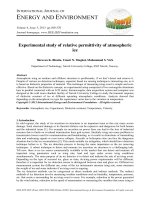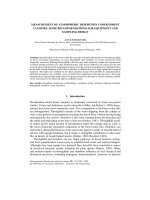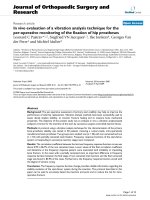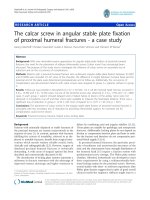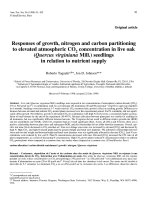fixation of atmospheric nitrogen ernst
Bạn đang xem bản rút gọn của tài liệu. Xem và tải ngay bản đầy đủ của tài liệu tại đây (1.95 MB, 167 trang )
Industrial Chemical Monographs
Fixation of
ATMOSPHERIC NITROGEN
4
V*i •*J-v-r-z°
^^^IT^
nftfl
JJUJ
FLOW DIAGRAM OF DIRECT SYNTHETIC AMMONIA PROCESS
Industrial Chemical Monographs
Fixation
of
ATMOSPHERIC NITROGEN
By
FRAME A. EIRNST
Fixed Nitrogen Research
Laboratory^
U.S. Dept, Agric; Formerly with
the Nitrate Division^ Army Ordnance; American Qyanamid Company
LONDON
CHAPMAN
& HALL, LTD.
ELEVEN
HENRIETTA
STBEET,
W.C.2
COPYRIGHT, 19283 BY D. VAN NOSTRAND, INC.
ALL RIGHTS RESERVED, INCLUDING THAT OF TRANSLATION INTO
THE SCAKDINAV-IAN AND OTHER FOREIGN LANGUAGES
PRINTED IN THE UNITED STATES OF AMERICA
ft Y THE PLIMPTON PRESS • NORWOOD - MASS,
FOREWORD
ALTHOUGH several books and a large number of pam-
phlets or articles have been written on various phases of
the fixation of atmospheric nitrogen, these have been for
the most part written by and for the scientist or technician
intimately interested in or associated with the work.
From the large number of questions and the nature of the
questions asked at the various technical society meetings
and from the number of letters which have come to me in
my official capacity on the staff of the Fixed Nitrogen Re-
search Laboratory, it was very evident that these books and
pamphlets had not served all requirements. It was then in
an endeavor to fill a need as was indicated by inquiries both
personal and by letter that this small volume was written.
This book is not, therefore, intended for the scientist or
technician familiar with the subject of the fixation of atmos-
pheric nitrogen, but is intended for the technical man of
other walks of life, for the teacher and student, for the busi-
ness man and the banker. It is hoped that this small con-
tribution will give the general information necessary to
influence its reader to become more deeply interested in the
subject and seek the other and more technical writings on the
subject.
In this volume an attempt was made to show the necessity
for nitrogen, and its sources; to give some historical facts
leading up to tint* present industry; to give a general descrip-
tion, neither wholly chemical nor wholly engineering, of the
NITROGEN
NITROGEN, the supply of which in utilizable forms is now
engaging the attention of all of the important and progres-
sive countries of the world, is one of the most plentiful
of the elements-
Although the ultimate source of practically all nitrogen is
probably the atmosphere, there are today four generally ac-
cepted commercial sources, viz,, the organics, the deposits of
natural nitrates, the deposits of coal and peat, and the
atmosphere.
For thousands of years the use of nitrogen compounds
was confined to the fertilizing of the land by the return to it
of animal and vegetable refuse- Just when such practice
was actually started by man is not known. It is reported,
however, that as early as the fourth century EX. the Egyp-
tians utilized camel dung which they dug from the Libyan
Desert near the temple of their god "Ammon.
11
It is
supposed that a salt comparable with our present "sal am-
moniac
J1
was also produced from this material. In ad-
dition to such manures, the organic nitrogen materials of
today include dried blood and tankage from the slaughter
house, cottonseed meal from the oil mills, fish scrap, leather
scrap,
waste products of the cocoa factory, and other simi-
lar materials.
The use of inorganic nitrogen started with the discovery
of the natural saltpeter deposits of India and for years a
i
2 FIXATION OF ATMOSPHERIC NITROGKN
lively trade in this material with the other countries of the
world was enjoyed. With the discovery of black powder,
the manufacture of which depended upon potassium nitrate,
these Indian deposits immediately assumed a position of
even greater importance. The nations of the world were
now dependent upon India for the material necessary for
national defense and preservation.
The demand for nitrogen compounds rapidly increased
with this introduction of military explosives and finally led
in 1830 to the discovery of the vast deposits of sodium
nitrate in Chile. Although these Chilean deposits almost
immediately assumed a position of importance it was with
the discovery of a method of manufacturing nitric acid, the
basis of our present smokeless powder and high explosives,
from this sodium nitrate that their real value was recog-
nized. Chile for years was almost the sole source of supply
of the world's inorganic nitrogen demands for both peace
and war.
Toward the end of the nineteenth century, another source
of available inorganic nitrogen was introduced with the
bringing into operation of by-product coke ovens- Coking
coals contain combined nitrogen in varying quantities up to
about 40 pounds per ton. In producing coke in the beehive
type of oven all this nitrogen, as well as many other valuable
constituents of the coal, are lost- In the by-product ovens,
however, a part of this nitrogen is driven off during the
coking process and 4 to 5 pounds per ton of coal coked are
recovered as ammonia.
Although it was long known that the atmosphere every-
where about us was composed of nearly 80 per cent nitro-
gen, this vast and inexhaustible source of supply was not
utilized until the beginning of this twentieth century. With-
NITROGEN 3
out this source of supply the World War would never have
continued for four years. Germany, because of an insuffi-
cient supply of explosives, would undoubtedly have been
forced to abandon hostilities at an early period. Yet even
though her fleet was held inactive she taught the world a
valuable lesson. At the very outset of the war, Germany
with but a few converted freight and passage ships, pre-
vented the exportation of nitrate from Chile for several
months. This blockade was so complete as to cause a very
alarming situation before It was broken. It demonstrated
the possible helplessness of a nation relying for its national
defense, In fact for its preservation, on a foreign source of
supply for its inorganic nitrogen- In time of war greatly
increased quantities of nitrogen are necessary not only for
explosives but for agriculture as well. The armies in the
field must be well fed while the health and hence contentment
of the people at home is also of paramount Importance.
Just as an army cannot be expected to light effectively on an
empty stomach, so a hungry nation cannot be expected to
support its armies. If the nitrogen supply is sufficient so
that the armies are victorious, but insufficient to provide also
for the needs of the remaining populace, then the cause
will undoubtedly meet defeat from within.
It is very evident that the consumption of war-time agri-
cultural nitrogen should be at least equivalent to, and if at
all possible, greater than the peace-time consumption.
Nitrogen for explosives must be additional. If the nitro-
gen is imported from a foreign source of supply, the neces-
sity for Increased transporting capacity for this war demand
occurs at the time when the country can least afford to divert
additional bottoms to this purpose. If a blockade of this
foreign source of supply — such as was successfully main-
4 FIXATION OF ATMOSPHERIC NITROGEN
tained by Germany for a period at the beginning of the
World War and was maintained against Germany during
the whole war—is effected, and the country is dependent
upon this source, then that country is almost inevitably
doomed to defeat through lack of munitions or starvation,
or both.
By increasing the consumption of agricultural nitrogen,
larger yields per acre may be expected. This will result
in either a greater total production or an equivalent produc-
tion from smaller acreage, and hence with less labor. Such
increased use of nitrogen might be a remedy for some peace-
time as well as war-time agricultural difficulties-
It is quite generally believed that Germany declared war
in 19T4 only after assuring herself that she had a suitable
source of fixed nitrogen within her own borders. The rate
of consumption of nitrogen in explosives during this war
was undoubtedly far beyond the expectations of any indi-
vidual or nation. In order to meet this demand it was nec-
essary, even with the enormous expansion of the rather
young atmospheric nitrogen fixation industry, to stint agri-
culture. How great an effect this had on the eventual re-
sult is rather difficult to appraise, but there Is no doubt that
the people of several of the warring nations suffered materi-
ally and still show the effects of malnutrition.
Although agriculture in peace time and agriculture and
military explosives in times of war are the large consumers
of nitrogen, It is being used in rapidly increasing quantities
in many industries. Agriculture is responsible for approx-
imately 80 per cent of the world's inorganic consumption.
In the United States, as much as 40 per cent of the con-
sumption is in chemical industries, the remainder going to
agriculture-
NITROGEN 5
Explosives are no longer to he associated only with
war. The use of peace-time explosives has grown tremen-
dously until today there is consumed in such pursuits as
mining, quarrying, road building and the cleaning of land
for cultivation, about 500,000,000 pounds annually of
high explosives. The chemical uses of nitrogen, largely in
the form of nitric acid, are in the manufacture of photo-
graphic films, artificial leather, artificial silk, imitation ivory
and dyes- In the form of ammonia, nitrogen is used in the
refrigeration industry for the manufacture of artificial ice
and in the operation of cold-storage plants; it has a wide
domestic use as household ammonia, and is used in the manu-
facture of soda ash, one of our most important staple
chemicals.
The provision of an adequate supply of such a vital
material must receive the greatest consideration of the vari-
ous nations of the world, both individually and collectively-
Four sources of supply were mentioned earlier and as it
has been shown that an unlimited supply is vitally neces-
sary, it will he well to consider the extent of these
sources.
Since soil nitrogen, or what may be considered the natural
nitrogen of the soil, is almost wholly confined to the surface
portion and since the imwcathered, underlying rock is devoid
of nitrogen, it is evidently of atmospheric origin. The
accumulations of soil nitrogen are the results of residues of
many generations of plants. This natural combined nitro-
gen is largely a constituent of organic matter and as such is
unavailable for plant use. It must he converted into simple
water-soluble compounds. The decomposition of such or-
ganic materials results in the conversion of the combined
nitrogen to ammonia. This ammonia is then oxidized by
6 FIXATION OF ATMOSPHFRIC NITROGKN
the soil bacteria to nitrites, which are further oxidized to
nitrates, which are quickly taken up by the growing plant.
Such accumulations of the soil nitrogen cannot be considered
as a source of our future supply of nitrogen.
The fixation of nitrogen is also accomplished by the bac-
teria within the tubercles of the plants. Professor Ilabcr
once remarked that the fixation of nitrogen in the future for
soil fertilization use would not be through great industrial
plants, but rather through plant and soil bacteria. Sod con-
ditions readily influence nitrogen fixation by leguminous
vegetation, particularly the supply of lime, and organic mat-
ter und the aeration of the sod. Tests have shown thut
LOO
to 200 pounds of nitrogen can be gathered in a good crop of
leguminous plants per acre. At the present time, however,
this method of nitrogen fixation cannot be depended upon to
supply our nitrogen demands.
"While the natural manures are widely used as fertilizer,
yet their availability is practically limited to this use. Sw.li
manures are a by-product and the supply cannot be in-
creased at will. The same is true of fish scrap, dried blood,
tankage, cottonseed meal, cocoa waste, etc. Approximately
70 per cent of the combined tonnage of these materials is
used for cattle feed, while the remainder is consumed in
mixed fertilizers. Such materials cannot then be considered
as a primary source of supply of nitrogen, but must be sup-
plemental to some other source.
In 1898, the world was rather rudely awakened by a
statement by Sir William Crookes, an eminent authority, to
the effect that the world was facing ultimate starvation be-
cause of its dependence upon the natural niter beds of Chile
for its nitrogen supply. While later investigations have
given assurance that the exhaustion of these deposits would
NITROGEN 7
probably have been further distant than was feared from
Sir William's statement, yet his warning was well founded
and timely.
At this time it appears certain that Chile could supply the
total demands of the world for at least 100 years into the
future. It is inevitable that exhaustion must occur, however,
and wisdom was shown in anticipating this condition and
guarding against its consequences- Although the 2240
square miles of nitrate-bearing ground which has been ex-
amined and proven is but 3 per cent of the total nitrate area,
yet there is no assurance that the remaining 97 per cent is of
proportionately equal value. It might be assumed that the
more likely areas have been worked first. On the other
hand, future working of this area might show these unex-
plored regions to be vastly more valuable than the present
workings-
There is still an economic question to be considered- The
world, in consuming some 2,000,000 tons of Chile nitrate,
has contributed to that country's support through the export:
tax nearly $25,000,000 for the year 1926. Of this amount,
the consumer in the United States paid approximately
$12,000,000. If nitrogen equivalent to that supplied by
this material could be secured within the borders of the
United States, even though at the same cost to the con-
sumer as Chile nitrate, the country as a whole w<ndd benefit
to the extent of $12,000,000, the tax which would have
been paid to Chile. If, on the other hand, production costs
are such as to permit reduction in cost to the consumer, the
dual benefit can be immediately seen.
This source of supply in Chile, while of great extent and
sufficient for a long period of continued exploitation, is also
of limited value both because of eventual exhaustion and
8 FIXATION OF ATMOSPHERIC NITROGEN
also because of the possibility of a nation being shut off
from this supply when it is most needed.
The third source of supply, coal by-products, is also lim-
ited. While coal, unlike sodium nitrate, is common in large
deposits to many parts of the world, its by-products cannot
be relied upon to furnish a nation's inorganic nitrogen. The
nitrogen from this source must be a by-product and hence
its production will not be dependent upon the demand for
nitrogen but rather upon the demand for coke. An increased
demand for nitrogen might be met by a decreased supply
from this source because of conditions which might have af-
fected the coke market which in turn depends upon the iron
and steel industries.
These three sources of supply then must be considered as
wholly inadequate. No nation can today afford to place en-
tire dependence upon any one, or even all of these three
combined. These sources must be considered as supple-
mental to some other principal source- This principal
source is the atmosphere.
The fourth source of supply, the atmosphere, must then
be the answer to the important question of an unlimited
supply. No nation is more advantageously situated as
regards this source than any other- It forms, as was pre-
viously stated, nearly 80 per cent of the air we breathe.
Over every square mile of the earth there is some 20,000,000
tons-
In fact, the atmosphere furnishes an inexhaustible
supply. It is apparent then that difficulties which prevented
its use were present and were only recently overcome.
Nitrogen is one of the more remarkable of all of the
ninety elements so far discovered. In the free form as it oc-
curs in the atmosphere it can be utilized neither by the bodily
mechanism nor in explosives or fertilizers- In the free state
NITROGEN , : ' 9
it is a comparatively inert gas, but once it enters.into com-
bination it displays the greatest activity both in the organic
and inorganic fields. Owing to the slight affinity between
nitrogen and the other elements with which it enters into
combination, many of its compounds are unstable and can
be decomposed with the almost instantaneous evolution of
heat and gas. Because of this slight affinity, military ex-
plosives almost without exception are nitrogen compounds.
In order to render this free nitrogen available for use
other than as a diluent for the oxygen of the air, it must be
combined with other elements. In this form it Is known as
fixed nitrogen. The nitrogen of the organics, of Chile ni-
trate,
and of by-product coke oven ammonia is already
fixed. In these cases the fixation has been accomplished by
slow natural processes. In the rapid fixation processes now
employed, the natural independence of the element has been
overcome by the ingenuity of'man. [f oxidized and absorbed
in water, it is fixed as nitric acid. This is the Arc Process for
atmospheric nitrogen fixation. Calcium carhide at red heat
will absorb free nitrogen as a sponge will water, thus
fixing the nitrogen in the form of calcium cyanamide by the
Cyanamide Process. Nitrogen will combine directly with
hydrogen under certain conditions, resulting in the fixing ol:
the nitrogen in the form of ammonia, according to the Di-
rect Synthetic Ammonia Process.
Nitrogen fixed in these forms can be readily converted
to other materials. Practically all modern explosives are
made by treating various substances with nitric acid; for in-
stance, smokeless powder from cotton and nitric acid; nitro-
glycerin, the basis of dynamite, from glycerin and nitric acid;
picric acid from carbolic acid and nitric acid; trinitrotoluene
— T.N-T- — from toluol and nitric acid; fulminate of mcr-
io FIXATION OF ATMOSPHERIC NITROGEN
cury from mercury and nitric acid; and ammonium nitrate
from ammonia and nitric acid. Calcium cyanamide gives
up its nitrogen in the form of ammonia when treated with
steam in an autoclave. Ammonia may be oxidized and ab-
sorbed in water to form nitric acid. It may also be used to
neutralize sulphuric acid to form ammonium sulphate; or
phosphoric acid to form ammonium phosphatej or carbonic
acid to form urea, or nitric acid to form ammonium nitrate.
C IIAPTE R I J
ATMOSPHERIC NITROGEN FIXATION
THE
chemist has known for many years how to convert the
inert free nitrogen of the atmosphere into compounds of
nitrogen in his laboratory- As early as 1774 Priestly iso-
lated ammonia, which in 1777 was shown by Scheclc to
contain nitrogen. Further work by Bcrthelot showed it to
be composed of one volume of nitrogen to three volumes of
hydrogen. In 1781, Cavendish noted the formation of ni-
tric acid when hydrogen was burned in air and in 1800
Sir Humphrey Davy made nitric oxide by passing air over a
wire heated by an electric current. In 1865 Deville passed
a nitrogen-hydrogen mixture through a porcelain tube and
found that ammonia was produced when the tube was
heated to about i30O°C. Although these and other reac-
tions of nitrogen were known, the reluctance of this element
to enter into combination limited progress for years to the
experimental laboratory. The quantities of product ob-
tained in this early work were distressingly small.
The warning of Sir William Crookes In tB98, however,
gave impetus to the work looking toward commercial fix-
ation of the nitrogen of the atmosphere. In 1902, the ap-
plication on an industrial scale of the combined results of
experiment and theory was attempted. In that year, the
Atmospheric Products Company was organized with a cap-
ital of $1,000,000- This company took over the process
and equipment patents of two Americans, C S. Bradley and
it
12 KIXATION OF ATMOSPHERIC NITROGKN
R. Lovqoy, and erected a large works at Niagara Falls,
New York. The industrial fixation of atmospheric nitro-
gen thus had its birth in the United States.
The process of Bradley and Lovejoy eiiects the direct
combination of the nitrogen and oxygen of the air to form
nitric oxide. By further oxidation and absorption of the
oxides by water, nitric acid of approximately 35 per cent
concentration is formed. This method of fixation is known
as the arc process.
Although this first plant might well be called a technical
success it was not an economical success and closed down
in 1904, after less than two years of operation. The yield
of 948 pounds of nitric acid per kilowatt year of power em-
ployed proved insufficient and the equipment besides being
costly was rather fragile, requiring frequent repairs.
The commercial possibilities for the direct oxidation of
the nitrogen of the atmosphere for the production of nitric
acid had heen demonstrated. Here was a possible means
of avoiding the serious situation indicated by Sir William
Crookes, Even before the plant at Niagara Falls had
discontinued operations, a furnace was developed in Nor-
way by
Prof.
Christian Birkeland and Engineer Samuel
Hyde, which proved to be both a mechanical and economi-
cal success. Ivxperimcnts with this furnace using 3 horse-
power were carried on early in 1903, and in October of
that year a small commcercial plant employing 150 horse-
power was started in operation at Ankerlokken, near Oslo,
This plant proved so successful that the following year
a plant of 1,000 horsepower capacity was erected near
Arendah
Tn 1905, the present works at Notoddcn were started
Into operation with a capacity of 2,500 horsepower. Sub-
ATMOSPHERIC NITROGEN FIXATION i •
sequent enlargements brought the capacity of this plant to
40,000 horsepower in 1907, 55,000 in 1911, and 60,000
in 1919. In 1911, the operating company, the Norwegian
Hydro-Electric Nitrogen Company (Norsk Hydro) started
a second works at Rjukan, for a consumption of 130,000
horsepower and added a second unit of similar size in
1915.
The Notodden and Rjukan plants arc still in opera-
tion with a combined consumption of 320,000 horsepower,
and an output of 38,000 tons of nitrogen fixed per year.
Other arc process furnaces developed and put into com-
mercial operation are those of Schonherr, Moscicki, Paul-
ing, Guye, and Wielgolaski. The installations other than
those at Notodden and Rjukan have been relatively small,
so that the total installed capacity Is approximately 45,000
tons of nitrogen per year.
Two further attempts have been made to establish the
arc process in the United States. In 1913, the Southern
Electro-Chemical Company, a subsidiary of the Southern
Power Company, incorporated under the laws of the State
of New York, erected a plant at Nitrolce, South Carolina.
This plant employed the Pauling furnace and was equipped
for nitric acid concentration and ammonium nitrate pro-
duction. The plant as enlarged in 19 15 was of a capacity
to utilize some 7,000 electrical horsepower. Its total con-
sumption for the month of March 1915, the best period of
operation, was at the rate of less than half that amount,
however.
During this month, the equivalent of 42.5 tons of 100
per cent nitric acid was produced, while 32 tons was concen-
trated, 20.5 tons packed and sold and 10 tons consumed in
ammonium nitrate manufacture. The manufacturing cost,
$90 per ton of concentrated acid exclusive of capital
14.
FIXATION OF ATMOSPHERIC NITROGEN
charges, and reckoning power at $10 per horsepower year
was high. This power rate of $10 per horsepower year was
far below the prevailing rate for that locality. The con-
sumption of over three horsepower years per ton of nitric
acid was too high, and rendered operation uneconomical, so
that theplant was closed down early in 1916, and operation
has never been resumed.
In the following year, the third attempt at establishing
the arc process in this country was made, and the fr*st per-
manent plant for the fixation of atmospheric nitrogen in the
United States was started- This plant, erected and op-
erated by the American Nitrogen Products Company, was
of about one ton of nitrogen per day capacity and was lo-
cated at Lc Grande, Washington. After enjoying nearly ten
years of operation, the plant was destroyed by fire in the
spring of 1927, and it is believed it will not be rebuilt.
The search for means of fixing nitrogen in the form of
alkali cyanides for gold extraction led to the work of Frank
and Caro, two eminent German chemists, during the close
of the nineteenth century. The patents granted these inves-
tigators in 1895-98 formed the basis of a process for the
fixation of atmospheric nitrogen known as the cyanamide
process, in which calcium carbide is produced through the
reaction between lime and coke in an electric furnace. By
the interaction of calcium carbide and pure nitrogen at a
red heat, the nitrogen is fixed in the form of calcium cyan-
amide.
The first commercial plant utilizing this process was put
into operation at Westeregcln nt^r Magdeburg, Germany,
in 1905, This plant was not a commercial success and was
abandoned in 1908. Some 800 tons of cyanamide had
been produced the first year. A second and successful plant
ATMOSPHERIC NITROGEN FIXATION 15
was started into operation in 1905, at Piano d'Orta, Italy.
The initial capacity of this Italian plant was 4,000 tons of
cyanamide per year. From this small beginning, the indus-
try enjoyed a rather rapid growth to its peak in 1918 of 35
plants of a rated capacity of 350,000 tons of nitrogen per
year. A large part of this capacity was erected for the war
emergency, so that after the war there followed a curtail-
ment of production and even a dismantling of some plants.
The first cyanamide plant erected on this continent and in
fact the first successful plant for the fixation of atmos-
pheric nitrogen was that of the American Cyanamid Com-
pany at Niagara Falls, Canada. This company was incor-
porated in 1907 under the laws of the State of Maine and
in 1909 started into operation a plant for the annual pro-
duction of
5,000
tons of cyanamide. Subsequent enlarge-
ments and improvements have increased the capacity to
120,000 tons of cyanamide per year, equivalent to 25,000
tons of nitrogen.
When in 1917, due to the urgency caused by war, it be-
came apparent that a large and positive source of fixed
nitrogen must be provided in the United States, it was
decided after careful consideration to erect a plant of the
cyanamide process. This plant of a rated capacity of
40,000 tons of nitrogen per year, the largest cyanamide
plant in the world, was erected at Muscle Shoals, Alabama.
It is known as U. S. Nitrate Plant No. 2, and except for a
two months' test run it has never operated.
Although attempts to produce ammonia directly from ni-
trogen and hydrogen date back to 1807, commercial In-
terest was not aroused until after the publication by
Prof.
Fritz Haber of a series of papers on this subject m 1905
and 1906. The Badische Anilin Und Soda Fabrik, in 1910,
16 FIXATION OF ATMOSPHERIC NITROGEN
took an active interest in the possibilities of this method
for the commercial fixation of atmospheric nitrogen and in
1913 started in successful operation a plant of a capacity of
7,000 tons of nitrogen per year. From this start, world
capacity of direct synthetic ammonia process plants has
rapidly increased to an operating and under-construction
capacity today of 979,000 tons of nitrogen per year. This
is more than double the installed capacity of the cyanamide
and arc processes combined.
The World War proved a great stimulus to the atmos-
pheric nitrogen industry. At the close of the year 1913,
or just prior to the outbreak of the war, there were in. oper-
ation seven arc plants of a capacity of 20,000 tons of nitro-
gen per year, 15 cyanamide plants of a capacity of 66,000
tons of nitrogen and one direct synthetic ammonia plant of
a capacity of 7,000 tons of nitrogen per year. Five years
later, the close of the year 1918, there were operating or
building and later put into operation, 12 arc plants of a
capacity of 40,000 tons of nitrogen, 35 cyanamide plants of
a capacity of 350,000 tons, and three direct synthetic am-
monia plants of 330,000 tons.
The period following the war has apparently favored
the direct synthetic ammonia process. The capacities in
tons of nitrogen installed and building for the various proc-
esses at this time are: arc, 5 plants of 44,750 tons; cyan-
amide, 28 plants of 315,500 tons; direct synthetic ammonia,
51 plants of 979,000 tons.
The first plant of this process erected in the United
States was the U. S. Nitrate Plant No. 1 at Sheffield, Ala-
bama. The imminence of war led to the passage in Con-
gress of Section 124 of the National Defense Act of June 3,
1916.
This section made $20,000,000 available to the
ATMOSPHERIC NITROGEN FIXATION 17
President for an investigation of the various methods for
the production of " nitrate and other products for muni-
tions of war and useful in the manufacture of fertilizers-
11
There followed the appointment of a committee of scien-
tists and engineers of the National Academy of Sciences in
co-operation with the American Chemical Society at the
request of the Secretary of War. In addition, two investi-
gators were sent abroad to study and report on conditions
in Europe. In the meantime the General Chemical Com-
pany had worked up and patented a modification of the
direct synthetic ammonia process as operated in Germany,
and made preparations for the erection of a plant- This
plant of 7.5 tons of ammonia per day capacity was to be
erected at Shadyside, New York.
The result of the various investigations made for the
Government was the recommendation that the War De-
partment take over the process of the General Chemical
Company and erect a pilot plant to test the process. Ac-
cordingly, U. S. Nitrate Plant No. 1 was erected at
Shef-
field, Ala. This plant of a capacity of 30 tons of ammonia,
including the 7.5 ton unit which was to have been erected
at Shadyside, was never completed. Only one unit of 7-5
tons of ammonia per day capacity was ready for trial op-
eration prior to the signing of the armistice. Continuous
operation of this unit was never realized, and only a small
amount of ammonia was produced.
In addition to these three processes, a great amount of
investigational work was done on other processes, and a
large number of methods have been proposed from time to
time for the commercial fixation of nitrogen- Very few of
these have appeared to present promising possibilities. It
must be remembered, however, that unforeseen develop-
i8 FIXATION OF ATMOSPHERIC NITROGEN
ments in our knowledge, or changes in the industrial situ-
ation due to new demands or supplies, may in the future
make possible the commercial success of processes at pres-
ent entirely impracticable.
In the cyanide process a mixture of sodium carbonate and
coke with iron in small quantities is heated in a stream of
pure nitrogen to a temperature of approximately iooo° C*
This operation results in the formation of sodium cyanide,
which may be decomposed with steam to yield ammonia.
The commercial development of this sodium cyanide proc-
ess was undertaken in the United States by the Nitrogen
Products Company according to the patents of
Prof.
J. E.
Buchei\ Experimental plants were erected at Saltville, Vir-
ginia and Greene, Rhode Island, while In 1918 the Govern-
ment undertook the erection of United States Chemical
Plant No- 4 at Saltville, Virginia, for the production of 10
tons of sodium cyanide per day by this process. Operation
of this plant started In September of that year, resulting In a .
production of some four tons of sodium cyanide. As oper-
ating costs proved to be too high to render the plant com-
mercially practicable for the production of either cyanide
or ammonia, operation was discontinued in December, and
the plant was later disposed of through salvage.
Of the various nitride processes, perhaps the one best
developed is that for making aluminum nitride from crude
aluminum oxide (bauxite), coke and nitrogen, heated in an
electric furnace to a temperature of about 1800° C The
aluminum nitride may be decomposed with steam or di-
lute caustic solution to yield ammonia and regenerate the
alumina.
Various small scale experimental plants of this process
have been constructed and operated in France, Germany
ATMOSPHERIC NITROGEN FIXATION 19
and the United States. The chief difficulty in all cases is in
securing economically the high temperatures necessary for
the reaction, and in obtaining materials of construction
capable of resisting these temperatures in continuous opera-
tion.
The explosion, or Hausser, process depends for the fix-
ation of nitrogen upon the fact that by exploding a mixture
of combustible gas with air or oxygen under proper condi-
tions high enough temperatures can be reached to bring
about the combination of a small amount of the nitrogen
and oxygen present. By this means it is attempted to bring
about the same direct combination of nitrogen and oxygen
that occurs in the arc process without its enormous expend-
iture of electrical energy.
Experimental plants in which operations have been con-
ducted in stationary bombs with mechanically operated
valves have been run at Hceringen and Neurernberg, (Ger-
many, The mechanical strains to which the apparatus is
subjected limit the developments. In its present state of
development this process cannot compe e successfully with
other processes for the fixation of atmospheric nitrogen.
Of these processes, the arc process requires the greatest
expenditure of electrical energy, tlie cyanamidc and nitride
processes rank next, while flic direct synthetic ammonia, cya-
nide and Hausser processes require only small amounts or
none at ail.
It is interesting to note that commercial development of
the three processes now in commercial operation stands in
approximately inverse proportion to the unit power con-
sumption of each. For instance, only six per cent of the at-
mospheric nitrogen fixed during 1926 was fixed'by the arc
process, which requires the expenditure of 61,000 kilowatt
